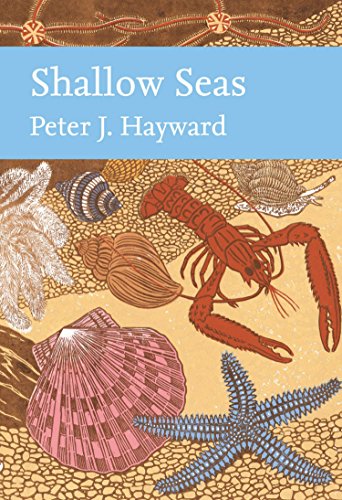Shallow Seas (Collins New Naturalist Library, Book 131)
Subjects, Peter Hayward
Shallow Seas (Collins New Naturalist Library, Book 131) par Peter Hayward ont été vendues pour EUR 40,99 chaque exemplaire. Le livre publié par William Collins. Il contient 416 pages et classé dans le genre genre. Ce livre a une bonne réponse du lecteur, il a la cote 4.4 des lecteurs 296. Inscrivez-vous maintenant pour accéder à des milliers de livres disponibles pour téléchargement gratuit. L'inscription était gratuite.
Moyenne des commentaires client : 4.4 étoiles sur 5 296 commentaires clientLa taille du fichier : 28.89 MB
Peter Hayward Shallow Seas (Collins New Naturalist Library, Book 131) livre pdf -
Shallow Seas are the most biologically rich and productive areas of the world ocean. This latest New Naturalist volume provides a natural history of this environment and its biological communities.
The margins of the continents, especially broad in the North Atlantic region, are drowned by shallow seas, creating a sea floor environment which is part of the wider and deepening benthic realm – the ecological region at the lowest level of a body of water such as an ocean or a lake, including the sediment surface and some sub-surface layers. These ‘shelf seas’ are the most biologically rich and productive areas of the world ocean. In his latest New Naturalist volume, Peter Hayward addresses some aspects of the natural history of the benthic environment of the shelf seas of northwest Europe and its biological communities.
Away from rocky coastlines the seafloor is rather flat, often muddy, beneath turbid water with low or no visibility. Benthic faunas mostly live within the sediment of the seafloor, or are sparsely and patchily distributed upon it, and if at all motile are likely to withdraw into burrows or move quickly away on disturbance. Yet, dredges and grabs reveal an often extraordinary diversity and density of animals, suggestive of complex interacting communities. This is not a textbook of marine benthic ecology, nor is it a comprehensive review of the benthic communities of the northwest European shelf seas. Rather, it describes the natural history of some benthic habitats and associations characteristic of our region.
Publié le: 2016-04-07Sorti le: 2016-04-07Format: Ebook KindlePrésentation de l'éditeurShallow Seas are the most biologically rich and productive areas of the world ocean. This latest New Naturalist volume provides a natural history of this environment and its biological communities.The margins of the continents, especially broad in the North Atlantic region, are drowned by shallow seas, creating a sea floor environment which is part of the wider and deepening benthic realm – the ecological region at the lowest level of a body of water such as an ocean or a lake, including the sediment surface and some sub-surface layers. These ‘shelf seas’ are the most biologically rich and productive areas of the world ocean. In his latest New Naturalist volume, Peter Hayward addresses some aspects of the natural history of the benthic environment of the shelf seas of northwest Europe and its biological communities.Away from rocky coastlines the seafloor is rather flat, often muddy, beneath turbid water with low or no visibility. Benthic faunas mostly live within the sediment of the seafloor, or are sparsely and patchily distributed upon it, and if at all motile are likely to withdraw into burrows or move quickly away on disturbance. Yet, dredges and grabs reveal an often extraordinary diversity and density of animals, suggestive of complex interacting communities. This is not a textbook of marine benthic ecology, nor is it a comprehensive review of the benthic communities of the northwest European shelf seas. Rather, it describes the natural history of some benthic habitats and associations characteristic of our region.Présentation de l'éditeurShallow Seas are the most biologically rich and productive areas of the world ocean. This latest New Naturalist volume provides a natural history of this environment and its biological communities.The margins of the continents, especially broad in the North Atlantic region, are drowned by shallow seas, creating a sea floor environment which is part of the wider and deepening benthic realm – the ecological region at the lowest level of a body of water such as an ocean or a lake, including the sediment surface and some sub-surface layers. These ‘shelf seas’ are the most biologically rich and productive areas of the world ocean. In his latest New Naturalist volume, Peter Hayward addresses some aspects of the natural history of the benthic environment of the shelf seas of northwest Europe and its biological communities.Away from rocky coastlines the seafloor is rather flat, often muddy, beneath turbid water with low or no visibility. Benthic faunas mostly live within the sediment of the seafloor, or are sparsely and patchily distributed upon it, and if at all motile are likely to withdraw into burrows or move quickly away on disturbance. Yet, dredges and grabs reveal an often extraordinary diversity and density of animals, suggestive of complex interacting communities. This is not a textbook of marine benthic ecology, nor is it a comprehensive review of the benthic communities of the northwest European shelf seas. Rather, it describes the natural history of some benthic habitats and associations characteristic of our region.
de Peter Hayward
4.4 étoiles sur 5 (296 Commentaires client)
Nom de fichier : shallow-seas-collins-new-naturalist-library-book-131.pdf
Si vous avez un intérêt pour Shallow Seas (Collins New Naturalist Library, Book 131), vous pouvez également lire un livre similaire tel que cc Early Humans (Collins New Naturalist Library, Book 134), Slugs and Snails (Collins New Naturalist Library, Book 133), Yorkshire Dales (Collins New Naturalist Library, Book 130), Farming and Birds (Collins New Naturalist Library, Book 135), Alien Plants (Collins New Naturalist Library, Book 129), Collecting the New Naturalists (Collins New Naturalist Library), Britain's Spiders: A Field Guide, A Natural History of the Hedgerow: and ditches, dykes and dry stone walls, Terns (Collins New Naturalist Library, Book 123), Nature in Towns and Cities (Collins New Naturalist Library, Book 127)
No comments:
Post a Comment